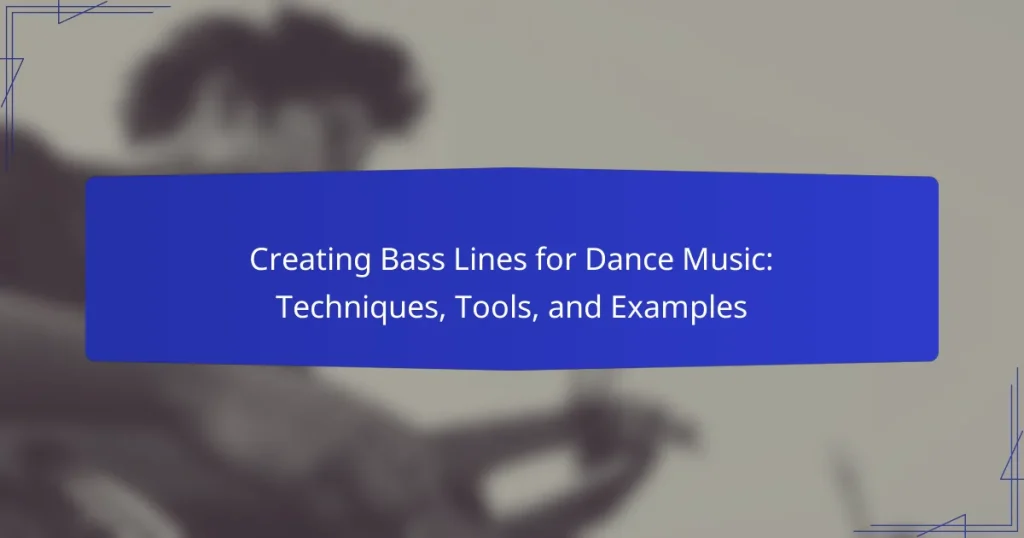Creating bass lines for dance music involves key elements such as rhythm, melody, harmony, and sound design. Rhythm establishes the groove, often enhanced by syncopation to improve danceability. Melody delivers a catchy hook, typically within a limited note range, while harmony ensures that the bass line aligns with the chord progression. Sound design focuses on the timbre and texture, employing synthesizers or samples to achieve specific auditory effects. Each of these components plays a crucial role in generating the energy and movement necessary for effective dance tracks.

What are the fundamental elements of creating bass lines for dance music?
The fundamental elements of creating bass lines for dance music include rhythm, melody, harmony, and sound design. Rhythm establishes the groove, often using syncopation to enhance danceability. Melody provides a memorable hook, typically utilizing a limited range of notes. Harmony supports the melody, ensuring the bass line complements the chord progression. Sound design focuses on the timbre and texture, often using synthesizers or samples to achieve a desired feel. Each element contributes to the overall energy and movement of the track, making it suitable for dance environments.
How do bass lines influence the overall sound of dance music?
Bass lines are fundamental in shaping the overall sound of dance music. They provide rhythmic foundation and drive the energy of a track. A strong bass line can enhance the groove and make the music more danceable. It often interacts with other elements like drums and synths to create a cohesive sound. In genres like house and techno, bass lines are usually deep and repetitive, which helps to establish a hypnotic effect. Research indicates that bass frequencies resonate well in club environments, making them crucial for live performances. Additionally, the use of varying bass line patterns can evoke different emotional responses from listeners. Overall, bass lines play a vital role in defining the character and impact of dance music.
What role does rhythm play in crafting effective bass lines?
Rhythm is crucial in crafting effective bass lines. It establishes the groove and drives the energy of a track. A well-structured rhythm creates a sense of movement and can enhance the overall feel of the music. Syncopation, for example, adds interest and complexity to bass lines. This technique involves placing notes off the regular beat, creating a dynamic effect. Consistent rhythmic patterns provide a foundation for other instruments. They help maintain listener engagement throughout the track. In dance music, a strong rhythm supports the beat, encouraging movement and dance. Ultimately, rhythm shapes the character of the bass line and influences the track’s impact.
How does melody contribute to the character of a bass line?
Melody significantly shapes the character of a bass line by providing harmonic context and emotional depth. A bass line often complements the melody, reinforcing its rhythm and supporting its tonal structure. This interplay creates a cohesive musical narrative. For instance, a melodic motif can inspire the rhythmic patterns and note choices in the bass line. When the melody ascends, the bass line may descend, creating tension and resolution. Conversely, a bass line can also mirror melodic phrases, enhancing their impact. This relationship is essential in genres like dance music, where rhythm and melody drive the energy of the track. Ultimately, the integration of melody into the bass line enriches the overall composition, making it more engaging for listeners.
What techniques are commonly used in creating bass lines for dance music?
Common techniques for creating bass lines in dance music include the use of synthesizers, sampling, and layering. Synthesizers allow for the design of unique sounds that can be tailored to fit various genres. Sampling involves incorporating pre-recorded bass sounds, which can add texture and authenticity. Layering combines multiple bass sounds to create a fuller, richer tone. Additionally, techniques like sidechain compression are used to create a pumping effect, enhancing the rhythm. Lastly, groove programming is essential to ensure the bass line complements the overall beat and enhances danceability.
How can layering different sounds enhance a bass line?
Layering different sounds can enhance a bass line by adding depth and richness. This technique allows for the combination of various frequencies, creating a fuller sound. For example, a sub-bass can be layered with a mid-range bass to provide both power and clarity. Additionally, layering can introduce texture, making the bass line more interesting. Using different sound sources, such as synthesizers and sampled bass, can create unique tonal qualities. This method is commonly used in dance music to maintain listener engagement. Studies show that well-layered bass lines contribute significantly to the overall energy of a track.
What are the benefits of using sidechain compression in bass line production?
Sidechain compression enhances bass line production by creating a dynamic interplay between the bass and kick drum. This technique allows the kick drum to cut through the mix more effectively. When the kick hits, the bass volume temporarily reduces, creating space in the frequency spectrum. This results in a clearer and more punchy mix. Sidechain compression also adds a rhythmic pumping effect, which can make the track feel more energetic. Additionally, it helps maintain a consistent level in the mix, preventing the bass from overpowering other elements. Overall, sidechain compression is crucial for achieving a balanced and professional sound in dance music production.
What tools are essential for creating bass lines in dance music?
Essential tools for creating bass lines in dance music include synthesizers, drum machines, and digital audio workstations (DAWs). Synthesizers allow for the design of unique bass sounds using oscillators and filters. Popular options are Serum, Massive, and Sylenth1, known for their versatility. Drum machines, like the Roland TR-808, provide iconic bass drum sounds that enhance rhythm. DAWs, such as Ableton Live and FL Studio, enable users to arrange and edit bass lines effectively. These tools are widely used in the industry, ensuring professional quality in dance music production.
Which software synthesizers are best for crafting bass sounds?
Serum, Massive, and Omnisphere are among the best software synthesizers for crafting bass sounds. Serum is known for its high-quality wavetable synthesis, allowing for rich and dynamic bass textures. Massive offers a powerful sound engine with a wide range of bass presets and modulation options. Omnisphere provides an extensive library of sounds, including deep basses that can be customized. Each of these synthesizers is widely used in dance music production, making them reliable choices for bass creation. Their popularity is supported by numerous professional producers in the electronic music scene.
How do MIDI controllers assist in creating bass lines?
MIDI controllers assist in creating bass lines by allowing musicians to input notes and control parameters easily. They provide tactile feedback for real-time performance. MIDI controllers enable precise note placement, which is essential for rhythm and timing in bass lines. Many MIDI controllers come with velocity sensitivity, allowing for dynamic expression in bass sounds. They also support various software instruments that can emulate bass sounds. This versatility allows for experimentation with different bass tones and styles. Additionally, MIDI controllers often include knobs and sliders for adjusting effects and sound parameters. This hands-on approach enhances creativity and efficiency in the music production process.
What are some examples of effective bass lines in popular dance tracks?
Some examples of effective bass lines in popular dance tracks include “One More Time” by Daft Punk. This track features a prominent, repetitive bass line that drives the rhythm. Another example is “Levels” by Avicii, known for its catchy and uplifting bass line that complements the synth melodies. “Titanium” by David Guetta, featuring Sia, includes a strong bass presence that enhances the song’s emotional impact. “Stay” by Zedd and Alessia Cara showcases a deep bass line that supports the vocal delivery. “Get Lucky” by Daft Punk also features an infectious bass groove that contributes to its danceability. These tracks highlight how effective bass lines can create energy and movement in dance music.
What characteristics make these bass lines stand out?
These bass lines stand out due to their rhythmic complexity and melodic hooks. The syncopation in the bass lines creates a compelling groove that drives the track forward. Additionally, the use of varying dynamics adds texture and interest. Unique sound design, such as the incorporation of sub-bass frequencies, enhances the overall impact. Techniques like sliding notes or pitch bends contribute to a more expressive sound. Furthermore, the integration of effects like distortion or modulation can create a distinctive character. These characteristics are essential in making bass lines memorable and engaging in dance music.
How can analyzing these examples improve your own bass line creation?
Analyzing examples can enhance your bass line creation by providing insights into effective techniques. These examples showcase various rhythmic patterns and note choices. Understanding how different bass lines interact with melodies can inspire your own compositions. Additionally, observing the use of dynamics and articulation in examples can inform your playing style. Studying the arrangement of bass lines within different genres reveals unique characteristics. This knowledge allows you to adapt and innovate in your own work. Ultimately, analyzing examples fosters creativity and technical skill development in bass line creation.
How can beginners start creating their own bass lines for dance music?
Beginners can start creating their own bass lines for dance music by understanding basic music theory and rhythm. Learning scales, particularly the minor and major scales, helps in note selection. Experimenting with different rhythms can create unique grooves. Utilizing digital audio workstations (DAWs) like Ableton Live or FL Studio provides tools for composition. Beginners should also explore synthesizers or bass plugins for sound design. Listening to popular dance tracks helps in understanding effective bass line structures. Lastly, practice is essential; creating multiple variations can enhance skills.
What are some common mistakes to avoid when crafting bass lines?
Common mistakes to avoid when crafting bass lines include neglecting rhythm and groove. Failing to align the bass line with the kick drum can create a disjointed sound. Overcomplicating bass patterns can lead to confusion in the mix. Using excessive notes can clutter the arrangement and reduce clarity. Ignoring the key of the song may result in dissonance. Not considering the frequency spectrum can cause muddiness in the mix. Lastly, avoiding dynamics can make the bass line feel flat and uninteresting. Each of these mistakes can detract from the overall effectiveness of the dance track.
What tips can help beginners develop their unique bass line style?
Experiment with different rhythms and patterns to find what resonates. Focus on groove and feel to enhance the bass line’s impact. Learn from existing bass lines in various genres to draw inspiration. Utilize techniques like slides, hammer-ons, and pull-offs to add character. Play with different note lengths and rests to create tension and release. Record and listen to your playing to identify strengths and areas for improvement. Collaborate with other musicians to gain feedback and new ideas. Regular practice and exploration will lead to a distinctive style over time.
Creating Bass Lines for Dance Music is centered around key elements such as rhythm, melody, harmony, and sound design. The article explores how bass lines influence the overall sound of dance music, emphasizing the importance of rhythm in crafting effective bass lines and the role of melody in shaping their character. It discusses various techniques for bass line creation, including the use of synthesizers and sidechain compression, and highlights essential tools like digital audio workstations and MIDI controllers. Additionally, the article provides examples of effective bass lines in popular dance tracks and offers tips for beginners on developing their unique style while avoiding common mistakes.


